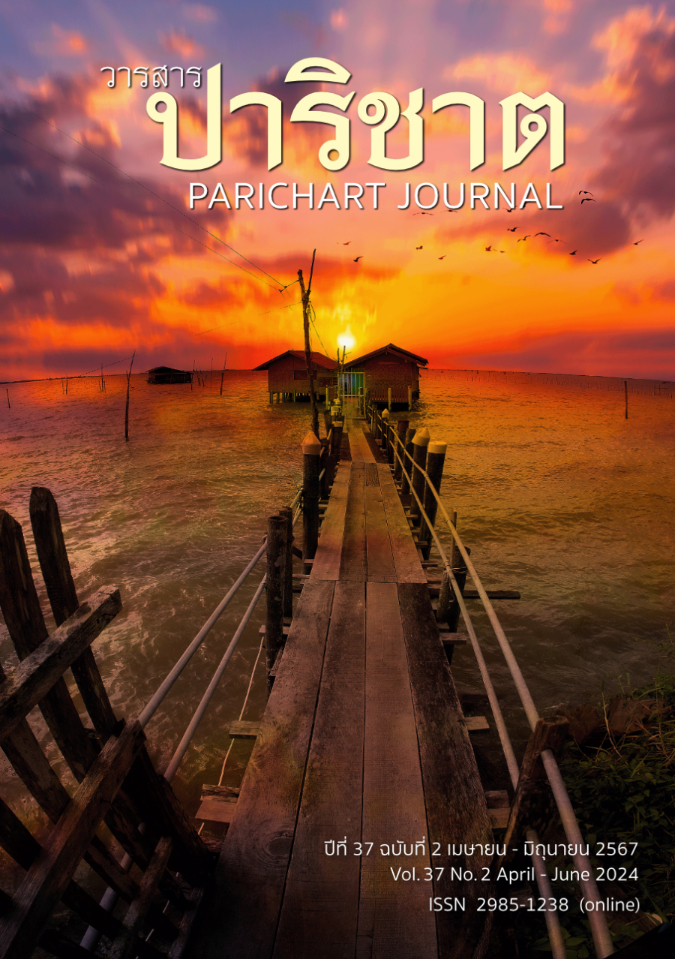/sòt/ : A Polysemy in Contemporary Thai
Main Article Content
Abstract
This research article aims to examine the use of the word /sòt/, a polysemy in contemporary Thai from the Thai National Corpus and 3 social media, namely Facebook, TikTok, and Twitter or X. The article studied 3 issues: positions and functions, semantics, and word formation dynamics. Analyzing the positions and functions of /sòt/ in contemporary Thai is based on sentence frames and semantic criteria. The results found 2 positions and functions of /sòt/: 1) the postposition of nouns: sub-intransitive verb word-class with the content word function; and 2) the postposition of verbs: adverb word-class with modifier function. The study of the semantics of /sòt/ in contemporary Thai is based on componential analysis. The results found 6 semantic feathers: 1) 4 semantic feathers’ postposition of nouns: sub-intransitive verb; and 2) 2 semantic feathers’ postposition of verbs: adverb word. Furthermore, the study found compound words from /sòt/. The word formation dynamic of /sòt/ is driven by combining /sòt/ with other elements, which extends the word’s meaning. Compounding forms are divided into 1) compound words from different words and 2) compound words from similar words.
Article Details

This work is licensed under a Creative Commons Attribution-NonCommercial-NoDerivatives 4.0 International License.
References
Saralamba, C. (2015). Language and Linguistics. Thammasat University Press.
Vongwipanon, P. (2003). Documents for teaching Thai language courses 3. Sukhothai Thammathirat University Press.
Falkum, I. L., & Vicente, A. (2015). Polysemy: Current perspectives and approaches. Lingua, 157(April 2015), 1-16. https://www.sciencedirect.com/science/article/pii/S0024384115000170?via%3Dihub
Royal Institute. (2013). The Royal Institute's Dictionary B.E. 2554 www.royin.go.th/dictionary.
Department of Linguistics Faculty of Arts Chulalongkorn University. (2007). TNC: THAI NATIONAL CORPUS. www.arts.chula.ac.th/~ling/tnc3. (in Thai)
Chosungnoen, Y., & Monwiset, S. (2023). /ta-ko:n/inContemporary Thai: A study of function and meaning. Ganesha Journal, 19(2), 47-63. https://so01.tci-thaijo.org/index.php/pikanasan/article/view/267983/175839 (in Thai)
Jaratjarungkiat, S. (2008). /jaŋ/: A diachronic study. [Master’s thesis]. ChulalongkornUniversity.CUIR.https://cuir.car.chula.ac.th/dspace/handle/123456789/59113?src=%2Fdspace%2Fsimple-search%3Fquery%3D%25E0%25B8%25AA%25E0%25B8%25B8%25E0%25B8%25A3%25E0%25B8%25B5%25E0%25B9%2580%25E0%25B8%2599%25E0%25B8%2595%25E0%25B8%25A3%26brw_total%3D2%26brw_pos%3D1&query=%E0%B8%AA%E0%B8%B8%E0%B8%A3%E0%B8%B5%E0%B9%80%E0%B8%99%E0%B8%95%E0%B 8%A3 (in Thai)
Iamsa-ard, B. (2022). The development of the particles “Lao La La Lae” in Thai [Unpublished doctoral thesis]. Kasetsart University.
Tejarajanya, B. (2015). Grammaticalization of Kaam and Khwaam nominalizers in Thai. [doctoral dissertation]. Chulalongkorn University. CUIR. https://cuir.car.chula.ac.th/dspace/handle/123456789/50145?src=%2Fdspace%2Fsimplesearch%3Fquery%3D%25E0%25B8%25A0%25E0%25B8%25B5%25E0%25B8%25A1%25E0%25B8%259E%25E0%25B8%25AA%25E0%25B8%25B4%25E0%25B8%25A9%25E0%25B8%2590%25E0%25B9%258C%26brw_total%3D1%26brw_pos%3D0&query=%E0%B8%A0%E0%B8%B5%E0%B8%A1%E0%B8%9E%E0%B8%AA%E0%B8%B4%E0%B8%A9%E0%B8%90%E0%B9%8C (in Thai)
Kullavanijaya, P. (2008). A historical study of /thii/ in Thai. In A. Diller, A. Edmonson, & Y. Luo (Eds.), The Tai-Kadai Languages (pp. 455-467). Routledge.
Diller, A. (2001). Grammaticalization and Tai syntactic change. In K. Tingsabadh (Ed.), Essays in Tai linguistics (pp. 139-142). Chulalongkorn University Press.
Jaratjarungkiat, S. (2015). Study of research methodology in the development of polysemes in Thai. Vannavidas, 15, 135-156.
Iamsa-ard, A. (2020). A Diachronic study of the word /khrâj/ [Unpublished master’s thesis]. Kasetsart University.
Kanchanachiwa, N. (1996). Thai grammar: Orthography, part of speech, syntax, and prosody. Thai Wattana Panich.
Jinlert, N. (2006). Classifying word categories in Thai grammar textbooks: Various methods and theories. Vannavidas. 6(November 2006), 189-216. https://so06.tcithaijo.org /index.php/VANNAVIDAS/article/view/62358/51340 (in Thai)
Phanuphong, W. (1995). The structure of Thai. Ramkhamhaeng University Press. (in Thai)
Partee, B. H. (2006). Lecture 1: Introduction to formal semantics and compositionality. https://people.umass.edu/partee/NZ_2006/NZ1.pdf
Pagin, P., & Westerstahl, D. (2011). Compositionality. https://www.academia.edu/85884102/ Compositionality
Evans, V., & Green, M. (2006). Cognitive linguistics: An introduction. Edinburgh University Press.
Facebook. (n.d.). /sòt/. https://www.facebook.com/
Nida, E. A. (2015). A componential analysis of meaning (2nd ed.). De Gruyter Mouton.
TikTok. (n.d.). /sòt/. https://www.tiktok.com/th-TH/
Twitter. (n.d.). /sòt/. https://twitter.com/sfkkfs_/status/1420402843714949126
Office of the Royal Society. (2017). Linguistics dictionary (general linguistics) Royal Institute Edition. Office of the Royal Society.
Hopper, P. J., & Traugott, E. C. (2003). Grammaticalization (3rd ed.). Cambridge University Press. [27] Oungwuttiwat, S. (2008). “Ti”: A polyseme in contemporary Thai. Vannavidas. 8(November 2008), 160-184.
Stern, G. 2018. Meaning and change of meaning. Forgotten Books.
Bybee, J. L. (2014). Language change. Cambridge University Press. [30] Injan, A., & Thepkanjana, K. (2015). Coordinate compound nouns in Thai. Humanities Journal. 22(1), 118-148.


